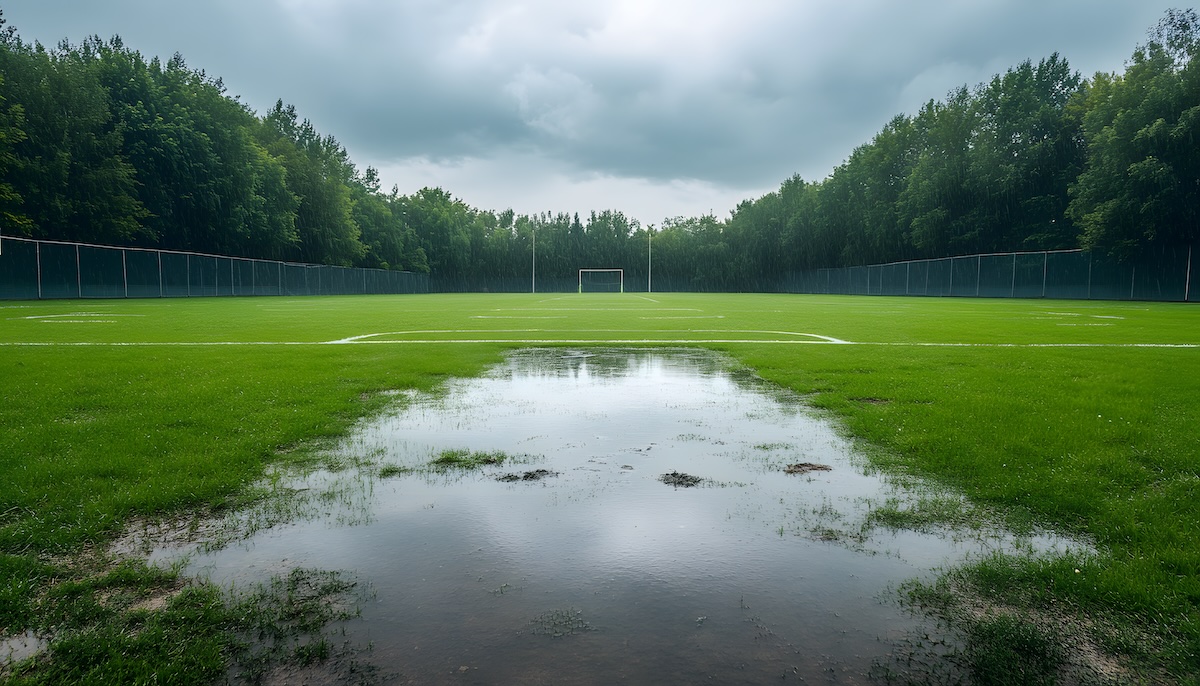Last Updated on April 15, 2025 by UDC Sports
When it comes to building a high-performance sports field, aesthetics and turf quality get most of the attention. A smooth, even playing surface that looks sharp and holds up to wear is what coaches, players, and fans notice first—and rightfully so. Whether it’s natural grass or synthetic, how that turf performs affects everything from safety to gameplay. And of course, nobody wants to invest in constructing a field that doesn’t look the part. So yes, turf quality gets a lot of the spotlight, and it should.
But the real test of a newly-built field doesn’t happen on day one. It comes the first time the sky opens up and pours down a few inches of rain in an hour. That’s when you find out what’s really “under the hood,” so to speak. It’s when a sports field either proves it was constructed correctly… or starts showing its flaws in a hurry. Because even the best turf in the world can’t save a field that wasn’t designed and built to drain.
A field’s longevity, playability, and maintenance costs all hinge on what’s hidden beneath the surface: proper grading, soil conditioning, and, most critically, drainage. Poor drainage and sloppy grading don’t just cause a few puddles—they wreck seasons, burn through maintenance budgets, and start conversations no one wants to have about reworking the field.
This guide zeroes in on the “bones” of athletic field construction: how drainage systems are built, how slopes are designed to move water where it needs to go, and what proper soil prep looks like when done right. These are some of the things that make the difference between a field that needs constant rescue and one that quietly performs for years.
Whether it’s a Friday night football field, a soccer facility with daily foot traffic, or a baseball diamond that needs to stay dry and playable through spring showers, the same principles apply.
What Is “Drainage” in Sports Construction?
In the context of sports field construction: Drainage refers to the system of slopes, layers, and subsurface infrastructure designed to move water off the playing surface and away from the field as quickly and efficiently as possible. That includes everything from the visible grade of the field to the hidden network of perforated pipes, gravel trenches, and engineered soil layers beneath the turf.
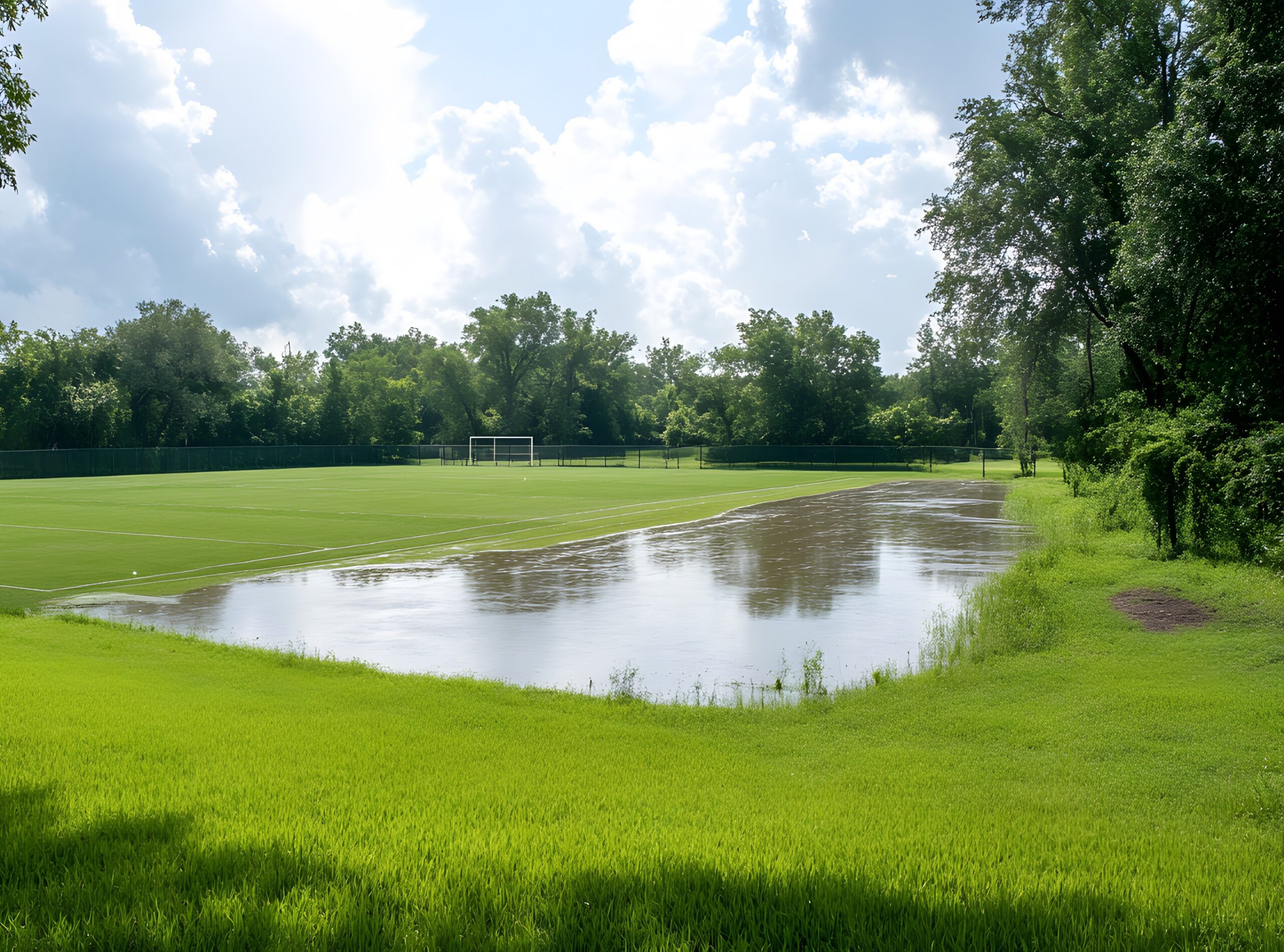 Drainage is what allows a field to recover after rain, resist damage from over-saturation, and stay safe and playable without delays. It’s not just about preventing puddles — it’s about protecting the turf, preserving the root zone (or synthetic infill), and avoiding compaction or erosion that can quietly ruin a surface over time. A properly drained field doesn’t just dry faster — it functions better, with fewer maintenance issues and a dramatically longer lifespan.
Drainage is what allows a field to recover after rain, resist damage from over-saturation, and stay safe and playable without delays. It’s not just about preventing puddles — it’s about protecting the turf, preserving the root zone (or synthetic infill), and avoiding compaction or erosion that can quietly ruin a surface over time. A properly drained field doesn’t just dry faster — it functions better, with fewer maintenance issues and a dramatically longer lifespan.
Better drainage is the reason some fields stay open, while others can sit waterlogged for days.
Why It’s More Important Than Many People Realize
If there’s one thing that quietly makes or breaks a sports field over time, it’s water management: The real nuts and bolts of how water moves, drains, and disappears without causing an issue. You can have the best turf money can buy, but if the field holds water, it won’t matter. Poor drainage turns even a brand-new sports surface into a problem child fast. You can end up with puddling in low spots, soft zones that never quite dry out, turf that starts dying off, weeds creeping in, and that slow slide into chronic maintenance issues.
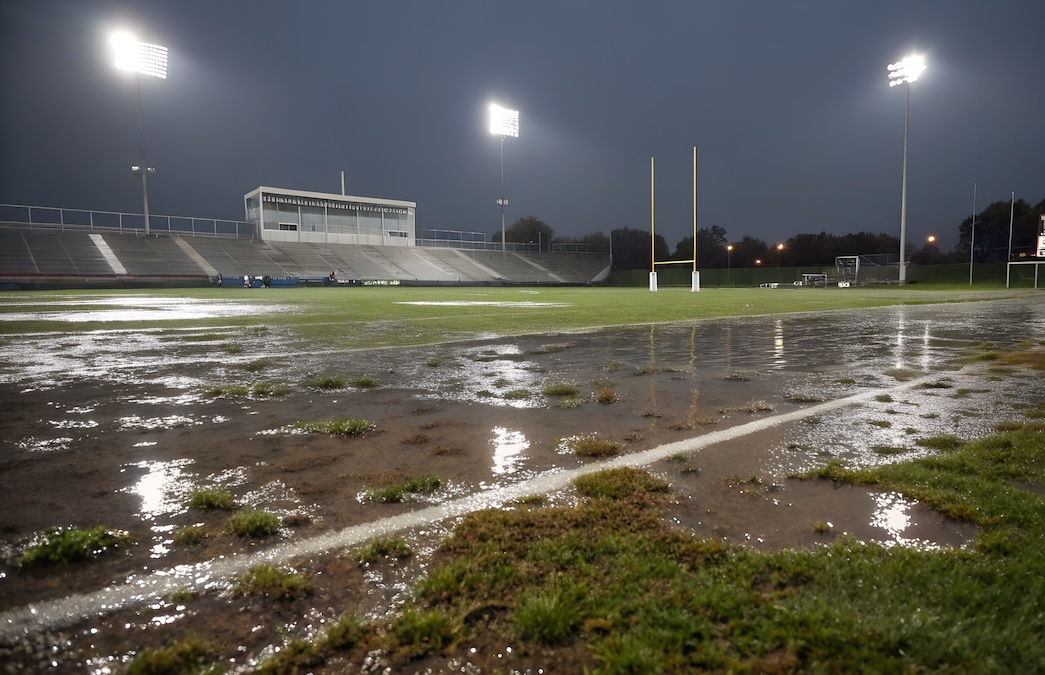
And that’s the best-case scenario. In the worst case, you could be looking at full-scale rework—peeling back turf, rebuilding the base, maybe even shutting down the field during peak season because it’s become a liability. It happens more than people think, and it’s almost always because drainage was either underbuilt, misunderstood, or treated like a checkbox by the contractor instead of a priority.
A well-designed, properly-built drainage system prevents:
- Game cancellations due to standing water
- Compacted or eroded infield areas
- Premature wear on synthetic turf or grass
- Unsafe conditions from slick, uneven surfaces
- Damage to sublayers or irrigation systems
Even artificial turf fields require significant drainage infrastructure. While a synthetic turf football field isn’t affected by overwatering in the way natural grass is, the water still has to go somewhere. Left unmanaged, it can degrade infill, flood adjacent areas, or saturate the base layers.
Puddling: What’s Normal, and What’s Not
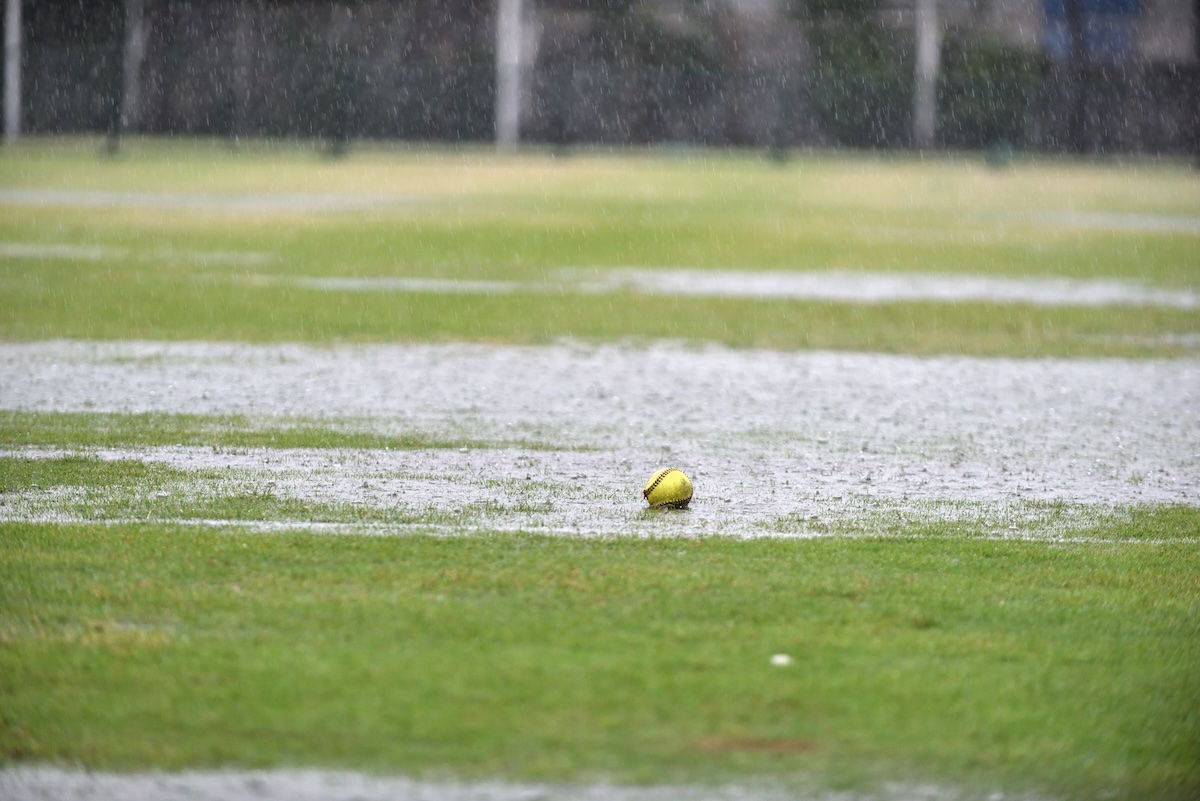
Even the best-drained sports fields can show signs of surface water during a downpour. A brief sheen or light puddling while the rain is still falling isn’t unusual—especially in areas with heavy clay content or during especially intense storms.
However, if water is still pooling more than 30–60 minutes after the rain stops, there’s a chance something may not be right. That level of puddling may point to poor grading, compacted soil, clogged subsurface lines, or a drainage system that was never designed to handle the volume it’s getting.
On a properly built field, water should begin moving immediately and disappear quickly. What you shouldn’t see is standing water across large areas, deep puddles in high-traffic zones, or soft spots that never quite dry out.
A few key signs of drainage trouble:
- Persistent puddling hours after rainfall
- Water that collects in the same areas repeatedly
- Turf thinning or discoloration in low spots
- Sloppy footing or squishy turf during regular use
The kind of water pooling seen on poorly drained fields—where balls sit half-submerged and play is shut down entirely is a sign the system below the surface isn’t doing its job well. Good drainage doesn’t mean water never puddles on the field. It means it doesn’t stay there.
Types of Drainage Systems in Sports Field Construction

Different sports, surfaces, and budgets call for different drainage strategies. Most athletic fields use one or more of the following systems:
1. Surface Drainage
This is the first line of defense. A slight grade or crown is built into the field to encourage water to flow away from the playing area. On a football field, this often means a subtle slope from the center out toward the sidelines. Soccer fields may use side-to-side or end-to-end grading depending on surrounding topography.
Typical surface slope specs:
- Football: 0.5–1.5% crown, center to sidelines
- Soccer/Baseball outfields: 1.0–1.5% side-to-side or end-to-end
- Baseball infields: 0.5–1.5%, often radial toward the base paths or foul lines
2. Subsurface Drainage
Beneath the surface lies a network of perforated pipes that channel water away from the field. These French drain-style systems are laid within gravel trenches beneath the turf base and connected to larger outflow pipes. Subsurface drains are essential for high-rainfall regions or where quick water removal is critical.
There are two main layouts:
- Herringbone Pattern: Common for rectangular fields like football and soccer. Pipes radiate from a central spine.
- Grid or Parallel Lines: Used where grading is uniform or where consistent drainage is needed across a wide area.
3. Sand Cap Drainage Systems
These are hybrid systems, often used on natural grass fields. A sand cap—typically 4–6 inches thick—is layered above native soil and engineered to allow rapid infiltration. Underneath, slit trenches or perforated pipes carry water away.
Sand cap systems dramatically improve drainage on native-soil fields and are increasingly popular for municipalities and school districts looking for better performance without switching to full sand-based rootzones.
Grading & Slopes
Getting It Right the First Time
Precision grading ensures water moves where it’s supposed to. This process is far more technical than simply sloping dirt. It requires laser grading, GPS-guided equipment, and an understanding of how the field will settle over time.
Key goals in grading:
- Promote consistent drainage flow
- Prevent low spots or ponding areas
- Ensure even footing across the playing surface
- Maintain proper dimensions for gameplay standards
It’s not just the field that needs consideration—sideline drainage, walkways, and adjacent landscape areas all influence how water behaves. Transitions between field zones (like a baseball infield to outfield or a soccer goalmouth to the box edge) need careful grading to avoid buildup or soggy turf.
Soil Preparation: Where Performance Begins

Before grass or artificial turf ever gets laid down, the soil must be conditioned to support drainage, root growth, and stability. The makeup of your base layer can make or break the field over time.
Soil Testing & Analysis
Lab testing helps determine soil type (clay, silt, sand), pH, organic content, and compaction potential. This guides decisions about:
- Amending soil with sand, compost, or other materials
- Choosing a turf species or synthetic system
- Selecting a base construction method
Common Soil Prep Techniques
- Amending with Sand: Helps break up heavy clays and improve infiltration
- Tilling and Laser Grading: Levels and loosens the soil for even root establishment
- Compaction and Rolling: Ensures a stable surface without overly restricting drainage
- Installing a Rootzone Layer: Sand-based fields often include specialized rootzone mixes to balance drainage and moisture retention
Considerations for Natural vs Synthetic Fields
| Feature | Natural Grass Field | Synthetic Turf Field |
| Drainage Needs | Surface & Subsurface | Subsurface Only |
| Soil Prep | Extensive | Focus on base compaction |
| Grading Precision | High | Very High |
| Maintenance | Mowing, Irrigation, Fertilization | Grooming, Infill Top-off, Occasional Sanitizing |
| Cost | Lower upfront, higher ongoing | Higher upfront, lower maintenance |
Each type has trade-offs. A well-drained natural grass field offers excellent cooling and traditional play but demands more upkeep. Artificial turf is extremely weather-resistant and durable but still requires proper subgrade work to avoid puddling and surface degradation.

Timeline & Cost Implications
Grading, soil prep, and drainage work tend to be the less visible parts of a sports field project, but they’re among the most important—and they shouldn’t be done quickly or cheaply. However, the return on that investment becomes obvious the first time the weather turns and the field stays playable.
Skipping or shortcutting any of this foundational work can seem like a savings at first glance, but it’s the fastest way to rack up long-term costs—not to mention the headaches that come with soggy turf, uneven footing, or emergency repairs during the season.
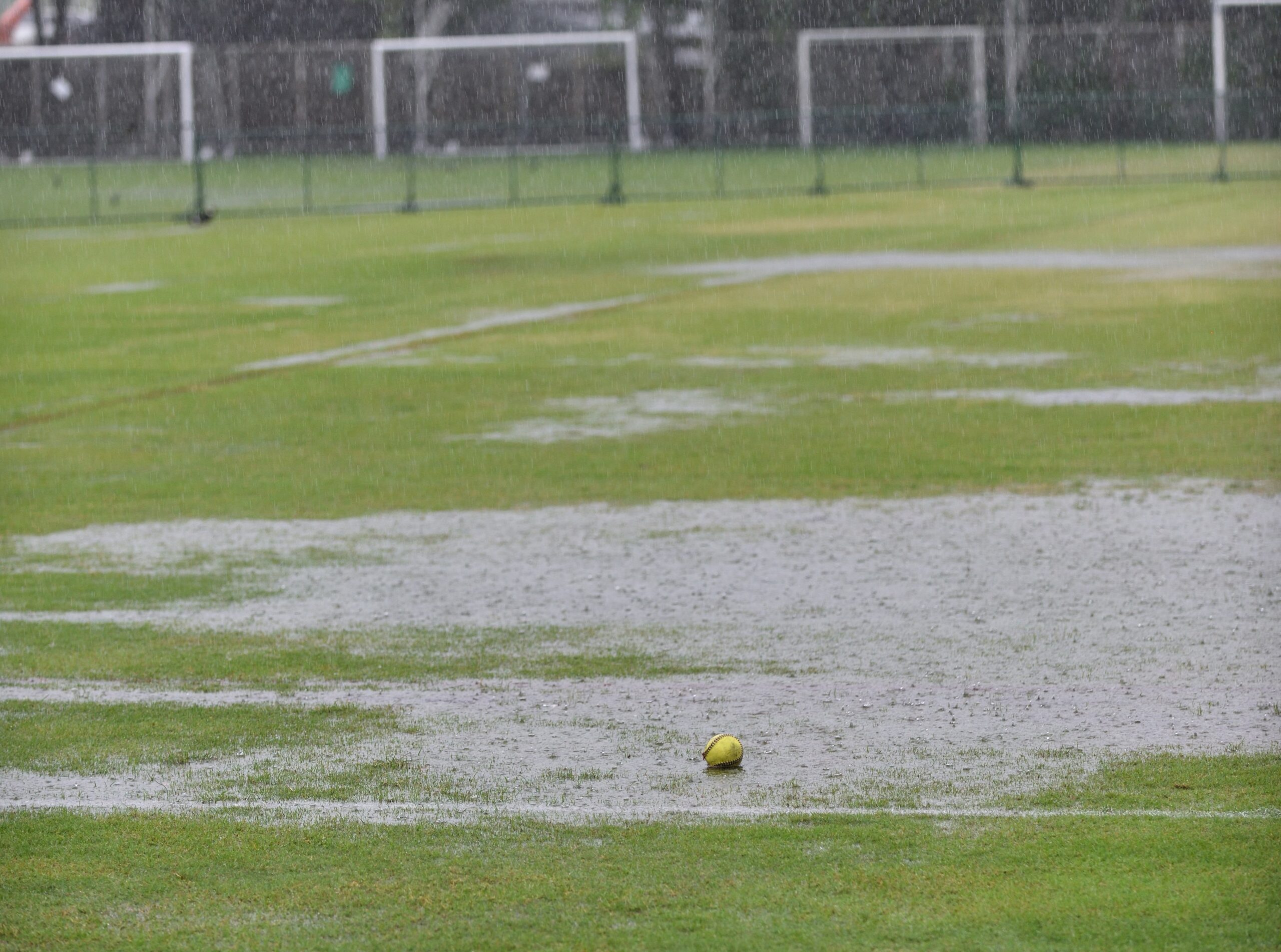
Proper grading and drainage can add some time and cost to a sports field project, but skipping them can cost exponentially more in repairs, turf failures, and downtime.
- Drainage System Installation: One of the more complex and labor-intensive phases. While it adds time and expense up front, it’s what prevents water from pooling and turning the field into a liability after storms. Poor drainage is one of the top causes of early turf failure and recurring field closures.
- Laser Grading: Takes time to get right, especially on larger or multi-sport surfaces. But it’s what ensures water flows as designed, and it directly affects both drainage performance and player safety. Precision here protects the integrity of everything above it.
- Soil Conditioning and Amendments: Varies by site, but always requires specialized attention. Native soils often need to be rebalanced to support drainage, compaction, and turf root structure. Skipping this step can create chronic maintenance issues that are tough to reverse later.
Trying to save time or money during this part of the design and construction process usually leads to major fixes being required later—from unplanned drainage installs to full resurfacing.
Investing in quality work during this phase is what lays the groundwork for an athletic field that actually performs year after year, not just during the first season.
Final Thoughts
Great sports fields start from the ground up. Turf, amenities, and finishing touches will always draw the spotlight—but it’s the invisible systems buried below the surface that determine whether a field holds up or wears out.
No one’s putting a drain line or a slope grade on a donor plaque. But those quiet decisions—the slope percentages, the subsurface layout, the soil profile—are what protect your budget, minimize long-term maintenance, and keep your field open when it matters most. When a surface drains right and stays playable after a heavy rainstorm, that’s well-planned infrastructure doing its job.

When sports construction companies and contractors cut corners beneath the turf, the problems always rise to the surface: puddles, uneven footing, blown-out budgets—not to mention frustrated players and fans. When you work with an experienced contractor who gets the grading, soil prep, and drainage right, you’ll end up with a new field that performs through heavy play, harsh weather, and packed schedules.
Prioritize the groundwork, and you don’t just get a better sports facility—you get a better return on every dollar spent. Because when your field drains right, everything else has a fighting chance.

